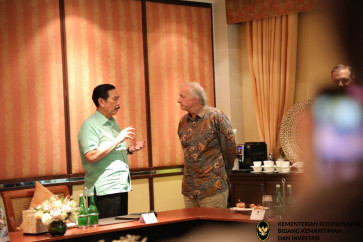Indulge in the sweet taste of a new year
Offerings: A temple goer places offerings to Sam Kwan Tay Tee, the King of Three Worlds, and to Wi To Pho Sat or Bodhisatva, the Protector of Temples, at the Dharma Bakti Temple in Petak Sembilan, West Jakarta
Change text size
Gift Premium Articles
to Anyone
 Offerings: A temple goer places offerings to Sam Kwan Tay Tee, the King of Three Worlds, and to Wi To Pho Sat or Bodhisatva, the Protector of Temples, at the Dharma Bakti Temple in Petak Sembilan, West Jakarta. Offerings usually include Nian Gao, locally known as Kue Keranjang (basket cake), oranges and apples. (JP/Bianca Winataputri) (basket cake), oranges and apples. (JP/Bianca Winataputri)
Offerings: A temple goer places offerings to Sam Kwan Tay Tee, the King of Three Worlds, and to Wi To Pho Sat or Bodhisatva, the Protector of Temples, at the Dharma Bakti Temple in Petak Sembilan, West Jakarta. Offerings usually include Nian Gao, locally known as Kue Keranjang (basket cake), oranges and apples. (JP/Bianca Winataputri) (basket cake), oranges and apples. (JP/Bianca Winataputri)
O
span class="caption">Offerings: A temple goer places offerings to Sam Kwan Tay Tee, the King of Three Worlds, and to Wi To Pho Sat or Bodhisatva, the Protector of Temples, at the Dharma Bakti Temple in Petak Sembilan, West Jakarta. Offerings usually include Nian Gao, locally known as Kue Keranjang (basket cake), oranges and apples. (JP/Bianca Winataputri)
Vibrant red and gold ornaments paint the city with a promise of good fortune as the local Chinese community celebrates the Lunar New Year. A celebration where cleaning and washing is done early, both close and distant relatives reunite and to one's dismay, cooking is forbidden.
Hundreds of treats can be seen along the streets in Glodok, West Jakarta, ranging from the 'must-haves' to luck-providing alternatives. Chinese New Year cuisine holds many superstitions carried along by the myths and legends embedded in it.

A must-have for Chinese-Indonesians celebrating Chinese New Year, locally known as Imlek, is Kue Keranjang or Nian Gao (basket cake), which is made out of sweet rice pudding creating a sticky texture. A dish frequently used as an offering to the gods, the basket cake symbolizes closeness and togetherness for families owing to its stickiness.
Resembling the basket cake is Kueku, glutinous rice cakes with a mung bean filling. These striking red delicacies are stamped with Chinese calligraphy and are also a form of offering. Yellow- or golden-colored Kueku are also popular in local markets, where they are sold in packs of eight.
'The number eight brings good luck and fortune. We also have fish-shaped cakes, as they are known to offer great success to many,' a saleswoman at Glodok Market said.
Alongside the tray of sweet rice cakes are fruit: specifically, apples and oranges. A symbol of peace and serenity from the apple and of good wealth from the succulent mandarin oranges, this platter is also a common offering to the gods.
Duck, chicken and fish are also served as part of a tradition with a catch that none of them are sliced. They must be served whole, as the Chinese believe that presenting them in pieces would tear away the good fortune and togetherness. There is no one way to cook them; what is important is the wholeness and the symbol of the meals themselves: fish for success and chicken for happiness and prosperity.
Traditionally, duck has a special value for this lively celebration as the Chinese ancestors believed ducks represented loyalty.
"Consuming duck on Chinese New Year offers hope for couples to stay loyal to one another. For married women longing for a child, duck eggs or chicken eggs should be provided, as they are a symbol of fertility,' Feng Shui expert and lecturer at Parahyangan University, Dewi Mariana, told The Jakarta Post recently.

Other Imlek culinary specialties include nuts and candies believed to yield for its eater many offspring; Spekkoek or thousand-layer spice cake, representing thousands of folds of good fortune; star-shaped jellies for the future to be as bright as the stars; pineapples as a symbol of greatness, and noodles for longevity.
However, there are several dishes that are forbidden during the celebration.
'Porridge is considered a dish for unfortunates that many people avoid during feasting. Despite rice being a compulsory dish on the day, the Chinese believe that white is the color of death and misfortune, so tofu is off the menu,' Dewi said.
The variety of cuisine enjoyed during the Lunar New Year is strongly attached to cultural traditions to which the Chinese-Indonesian community strongly adheres. A great deal of luck, fortune and superstition has long been engrained in these culinary festivities, encouraging many to indulge in the sweet taste of a new year.
The writer is an intern with The Jakarta Post









